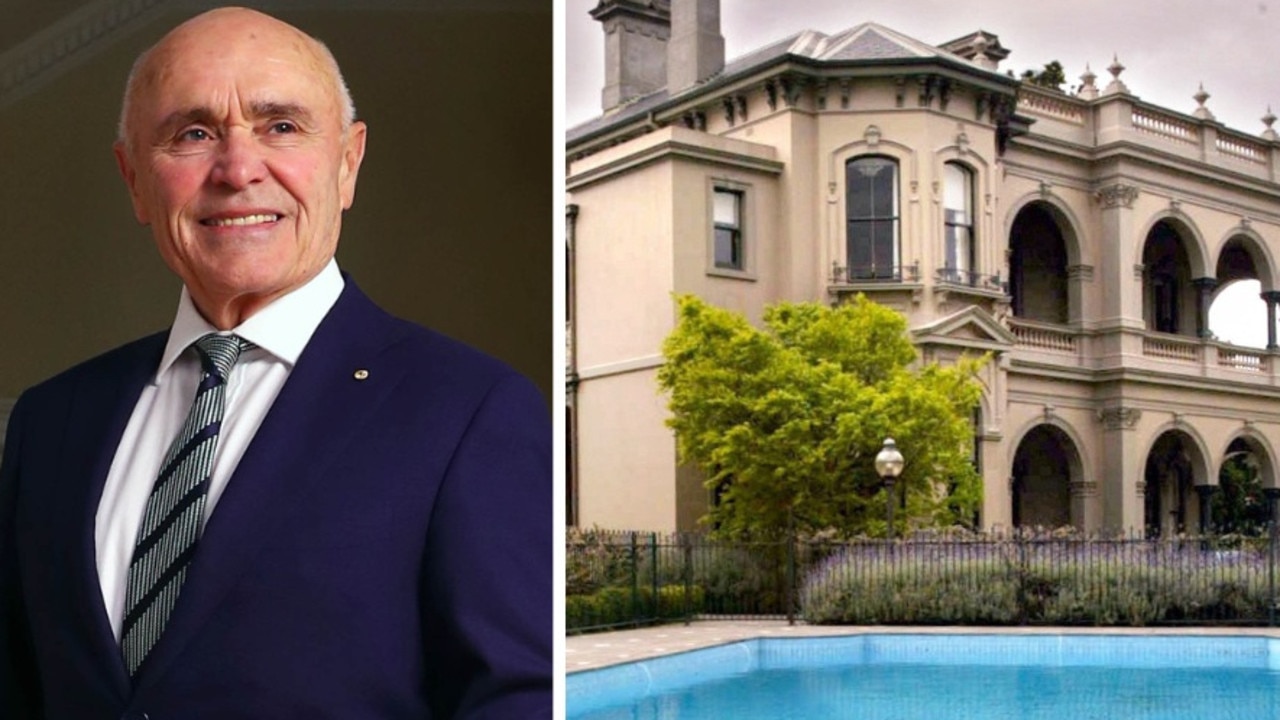Good Friday Appeal 2021 RCH: Faces of the Royal Children’s Hospital
These brave battlers have endured marathon stints in hospital, extensive treatment and rare conditions but keep on fighting.
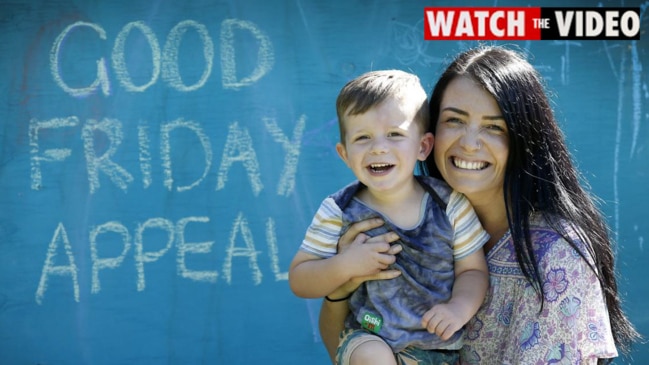
It defies belief that you can detach half a toddler’s brain, and they will be left better off than before.
But when seizures threatened to steamroll Malu’s development, Erin Johnson and Morgan Hunt had no option left for their youngest son.
They had to trust that the recommendation for a rare and radical brain surgery at the Royal Children’s Hospital would preserve the life and future development of Malu.
“Even though the seizures were coming from one side, it affected the whole brain. It makes sense his half a brain was better than using his whole brain,” Ms Johnson said.
“It’s incredible. It still blows my mind.”
The brain’s ability to rewire is amazing. Six weeks after surgery, Malu started walking again. Next came the first words. He has learnt to ride his birthday trike, and is building up the confidence to chase his brothers in the backyard.

A PARENT’S HEARTFELT THANKS
There is a particular type of scream parents reserve for issuing a cry for help for their child.
I knew this sound instinctively when I heard it while I was watering the vegie garden.
“The glass. The glass,” my husband Hayden kept yelling.
He was holding our one-year-old daughter Fenella, screaming and bleeding all over.
A newly installed heated ceiling light had shattered all over her as she sat on the bathmat, getting dry.
Every spot where the shards landed on her, she was flecked with blood.
I’ve covered the Good Friday Appeal for the Herald Sun for more than 10 years - walking the wards, invited into operating theatres and watching the tender touches between families, kids and medics.

But until you need their services as a parent, it’s hard to really understand the power of the Royal Children’s.
It wasn’t until we arrived at ED that the full extent of Fenella’s injuries were clear.
She had suffered third degree burns across her shoulders, neck, legs and arm.
When plastic surgeons start talking skin grafts, and preparing you for the fact you’ll be a patient at the burns clinic for at least the next year, you would do anything to change places with your child.
But the care we have been shown has been second-to-none.
In our regular appointments, we are seen by two plastic surgeons, two nurses, two burns physiotherapists and a play therapist.
You can’t beat that care.
This has been a different Good Friday Appeal for my family this year. I am so grateful we are in the right city, at the right time, to access their amazing care and I give thanks this Easter.
PIPER’S LONG ROAD HOME
Piper Crawford’s family live life on the edge of a cliff.
When the six-year-old is seizure free it’s a stunning view but they could topple at any time.
“We’re now in a place where we know we are going to get through to the other side, and we’ve learnt to really appreciate those windows in between and what quality of life is,” mum Sara said.
Herald Sun readers first met Piper four years ago when she was aged two.
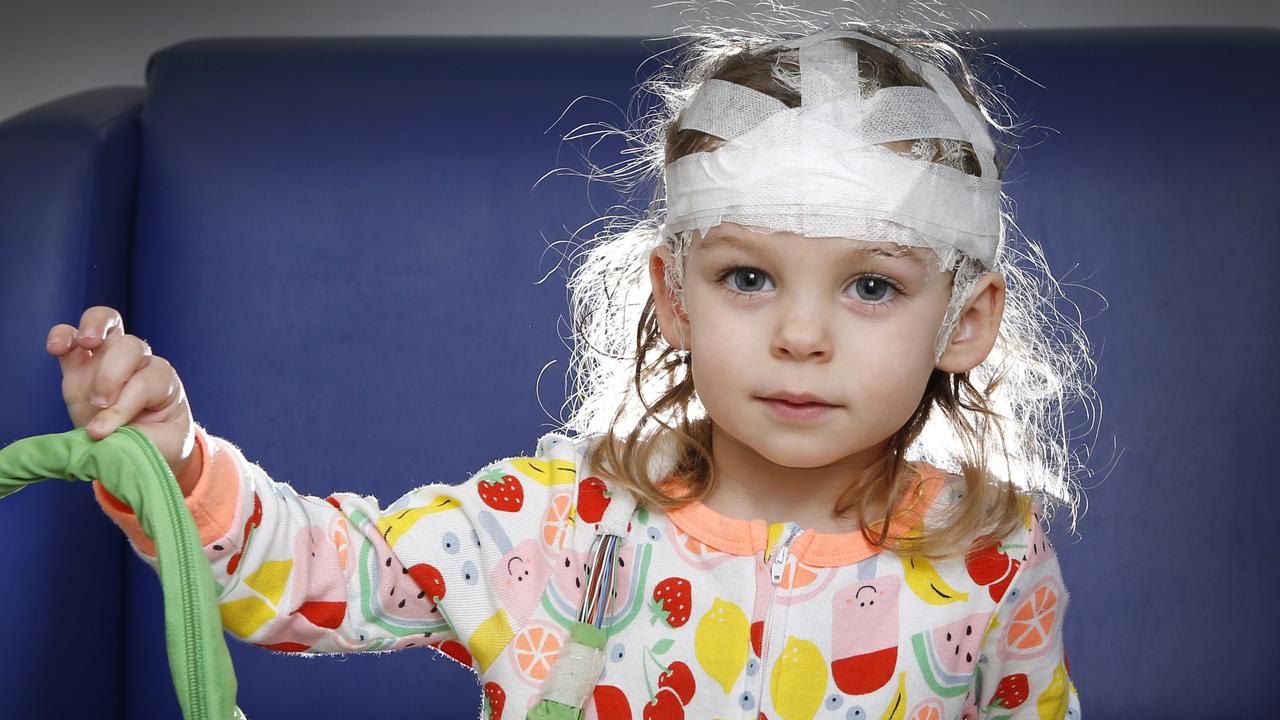
She had been hit with eight massive clusters of epileptic seizures in as many months. The toddler needed to be resuscitated after most episodes.
Each cluster saw her needing to relearn how to walk, talk, think and even move her eyes again.
Genetic testing revealed that her seizures were caused by a rare gene mutation.
Piper has been treated by a series of firsts at the Royal Children’s Hospital over the past two years. She has lived in ICU as a long term patient and has been one of the youngest children to have a “pacemaker for the brain” implanted.
And now, a new drug delivery system is aiming to finally bring better quality of life to Piper and her family, despite her being plagued by seizures.

“There is still a lot of joy and positivity in our life, even in hospital,” Mrs Crawford said.
“We’ve got a very sunny, humorous little girl that makes our day.”
For the Crawfords waking up in the same house together was their simple wish.
“We’re ready to spread our wings and embark on the next chapter of our journey, which hopefully involves a lot more togetherness and time at home,” she said.
RIVER’S OF JOY
River Reid was dying.
In just three weeks, a rare blood cancer had taken such a strong hold on the six month old, that the brain and spinal cord were the only parts of her body where there were no tumours. Now after 147 nights at the Royal Children’s Hospital and a “perfect” response to treatment, the one-year-old is now home and free to start living life untethered to tubes, drains, monitors and machines.
“The doctors keep looking at her and saying she’s remarkable, she’s an inspiration,” said mum Julia Reid.

“Until just this month, I haven’t let herself think about the future. But she’s passed the first three months still in remission.“At the end of the street is the school she will go to. We walk past it and I can now let myself think; she will go to this school.” A low grade fever was the first sign Julia and Simon’s youngest child was sick. But after a week she went downhill quickly, scans eventually revealing masses throughout her body.“It’s literally like an atomic bomb goes off in your life,” Julia said. Tests found that River had stage four Anaplastic large cell lymphoma. It had caused hundreds of nodes to grow all through her body and organs.
River endured 60 doses of high-dose chemotherapy back-to-back for 20 weeks. Her response to the treatment was “perfect” and River is now loving her second chance at life.
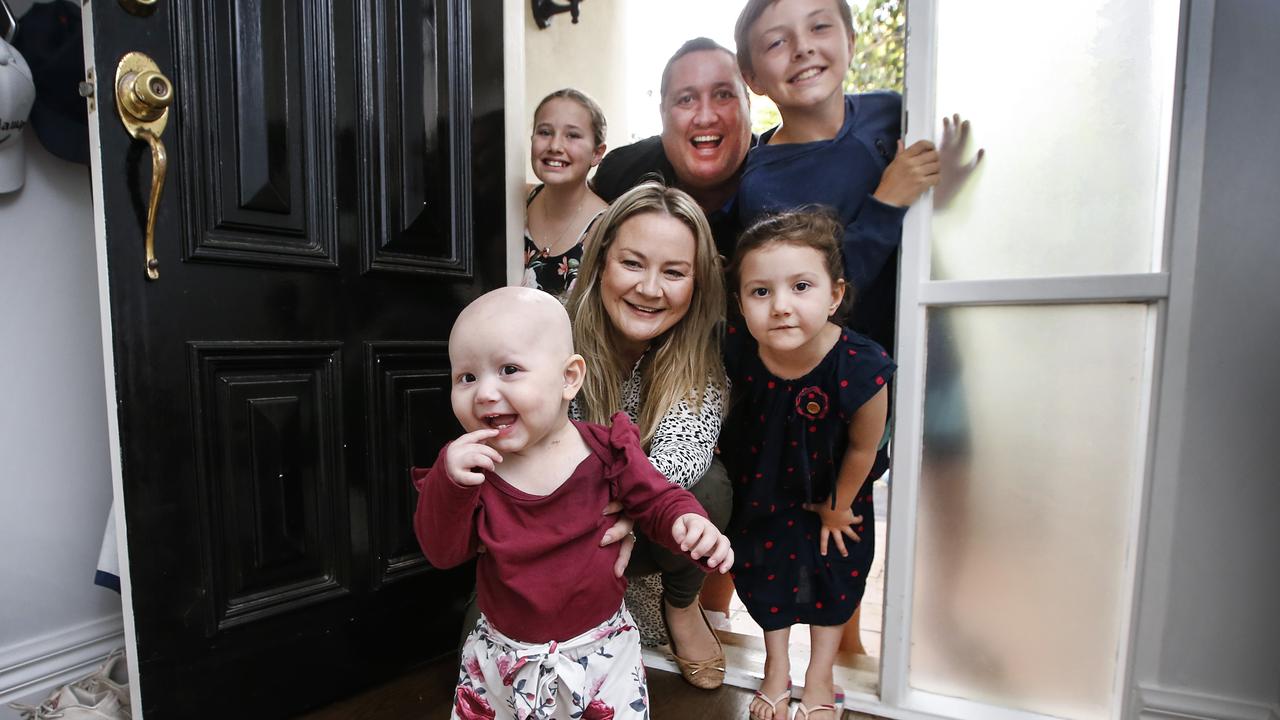
THE BOY WHO CAN’T STOP LAUGHING
Elliott Cimino can’t stop smiling and laughing. He can’t help it.
The four-year-old’s ever-sunny appearance is a hallmark of his rare genetic condition. And while his personality is a blessing for his family, it also masks the seriousness of his condition.
Elliott has hundreds of seizures a day, and that’s on a good day. He looks like he has been struck by lightening over and over and over.

These episodes can heartbreakingly last for two hours.
But a strict high-fat low carb diet is so far working wonders. Instead of hundreds of seizures a day, since starting the plan under the care of the Ketogenic Diet Clinic at the Royal Children’s Hospital Elliott is now having one seizure every other day.
With the neurologicalelectrical storm off the radar, this has freed his brain to start learning the basics of childhood for the first time, including taking his first steps with a walker just before his fourth birthday.
“It’s been life changing. It’s amazing,” said mum Chrissy.
KICKING GOALS FOR KIDS
Hasti Momeni was never expected to walk, but she’s now up on her feet and kicking goals.
The bubbly 13-year-old, who suffers from spondyloepiphyseal dysplasia (SED), has been subjected to 19 surgeries but is slowly starting to defy the odds.
The congenital abnormality has impacted Hasti’s bone and joint development since birth, meaning she’s struggled with all movement and physical activity.
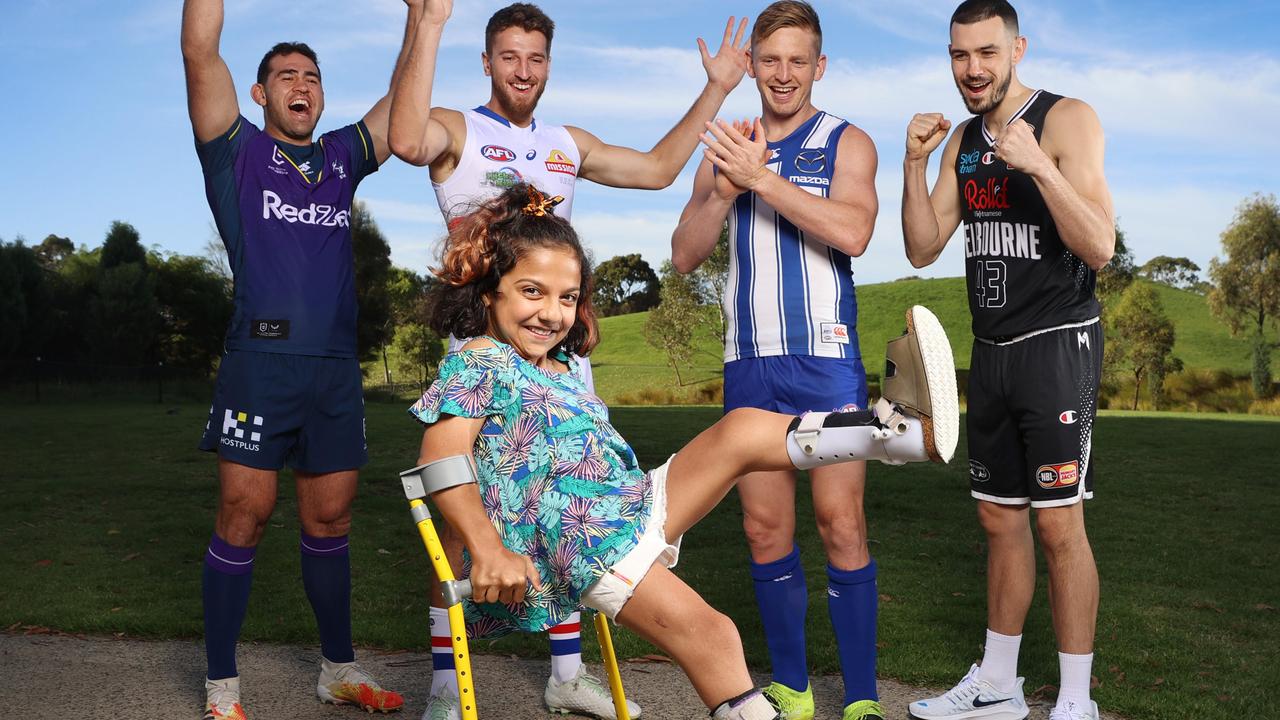
But now, thanks to the tireless work of the Royal Children’s Hospital, the Pascoe Vale teen is racing towards her goal of walking without crutches.
Western Bulldogs and North Melbourne will face off in the Kick for the Kids clash, while Melbourne Storm will dedicate its match against the Brisbane Broncos to the appeal. The NBL’s Melbourne United will donate $1 from every ticket sold for its match against the Cairns Taipans.
North Melbourne skipper Jack Ziebell – whose team will take on the Western Bulldogs – said the club was excited to play on such a special day.
“It’s one of the very few occasions during the season where footy is just about put aside and you’re playing for a greater cause to help the Good Friday appeal,” Ziebell said.
“It’s a big spectacle for our footy club and probably the No. 1 game for us this year, so it’s important we put on a good show.”
COWBOY KICKS CANCER
Having a child with cancer is a hard road to walk.
For families like Eddie Biemans, they take strength and solace in the resilient way their child endures the treatments, and by the dedication of the medical team at the Royal Children’s Hospital.
“It’s a really surreal situation. You have to put your blinkers on, like horses do, and just have the vision of getting out of it and dealing with everything else later,” said Sammy.
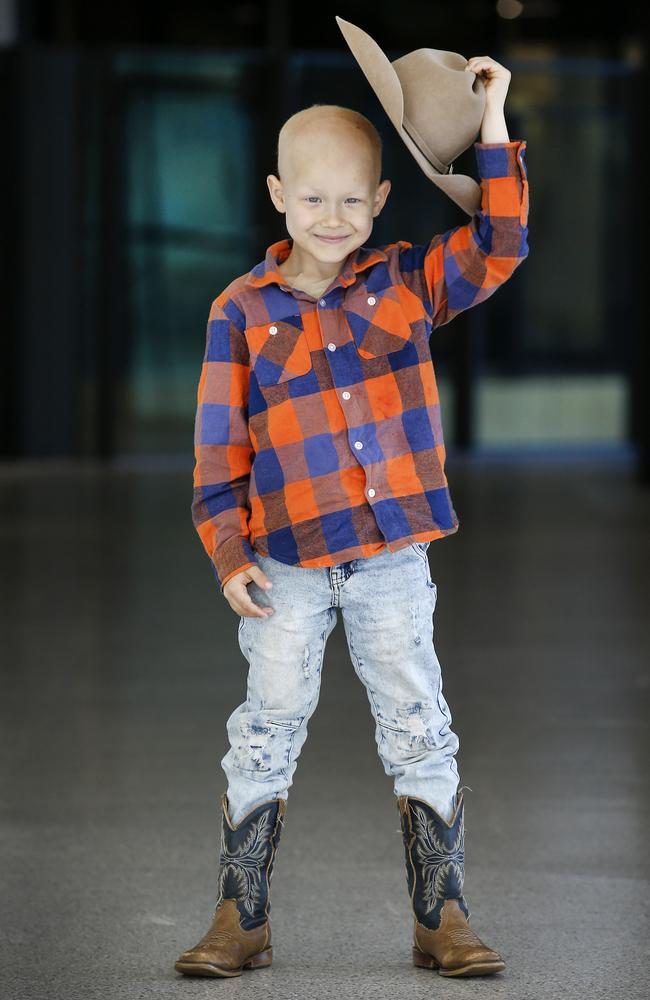
Despite the cancer initially spreading to his lungs, high-dose chemotherapy cleared it.
The Alberton boy had surgery two days before Christmas to remove the tumour and most of his liver and gallbladder.
With treatment now finished, the family will travel to the RCH for monthly blood tests and regular scans for the next two years.
About 200 young people come through the door of the Royal Children’s Hospital’s Children’s Cancer Centre each year.
“We cure somewhere between 80-85 per cent of children who walk through the door. Not extend life, which is the focus of care for adult medicine, we cure,” said paediatric oncologist Jordan Hansford.
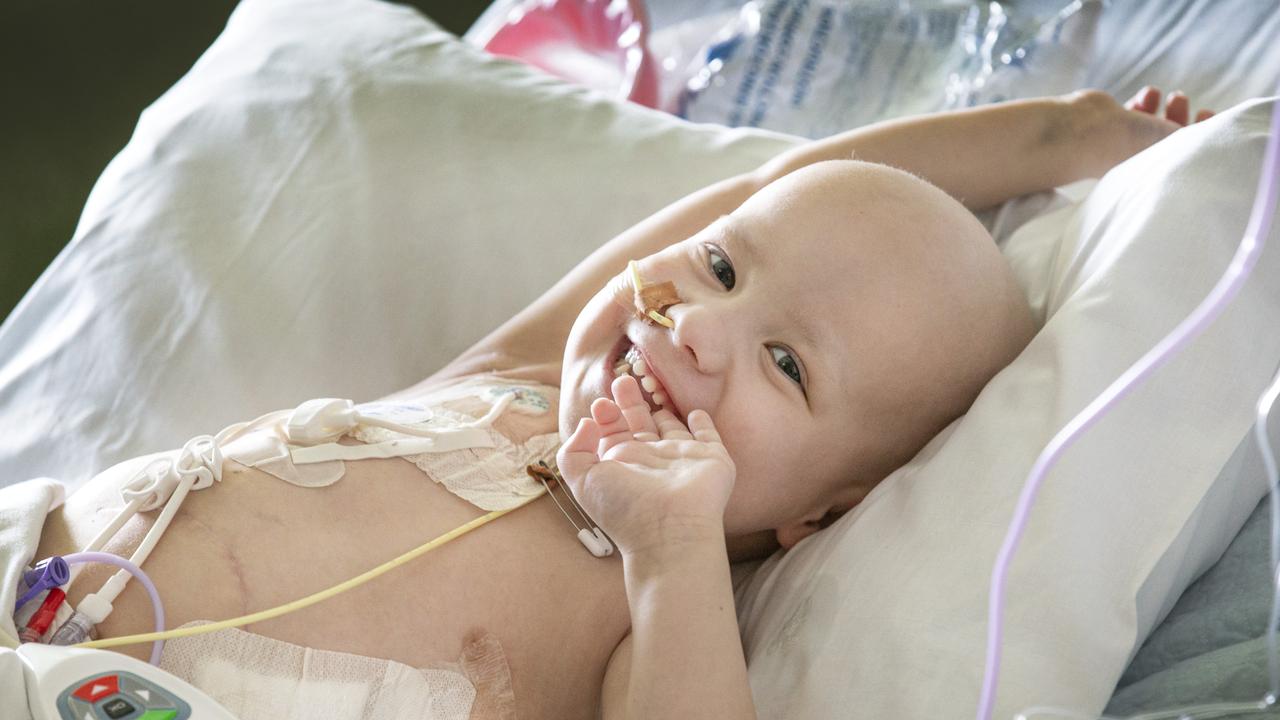
All the tools in the oncologist’s tool bag are being thrown at three-year-old Oli Pluelkhahn, after he was diagnosed with a rare and aggressive neuroblastoma in September.
Further down the ward is Nolan Hiotakis 7, is experiencing his own side effects from chemotherapy. The treatment for his brain tumour has caused him to be sensitive to light, meaning he must put on his shades when chilling out at the end of the ward.

But Dr Hansford, who also runs the oncology clinical trials unit, said they relied on philanthropy donations to fund their mission statement of getting each child access to the most promising treatment.
“Our model of care is such that every child who walks through the door and needs treatment, our goal is to enrol them on a clinical trial,” he said.
“The only way we get success with these children is through our collaborative clinical trials. “Much of our money to staff and operate this program is soft, it’s not ongoing.
“We’re reliant on the goodness of public will through the Good Friday Appeal and through other charities and competitive grants, to help run our facility.”
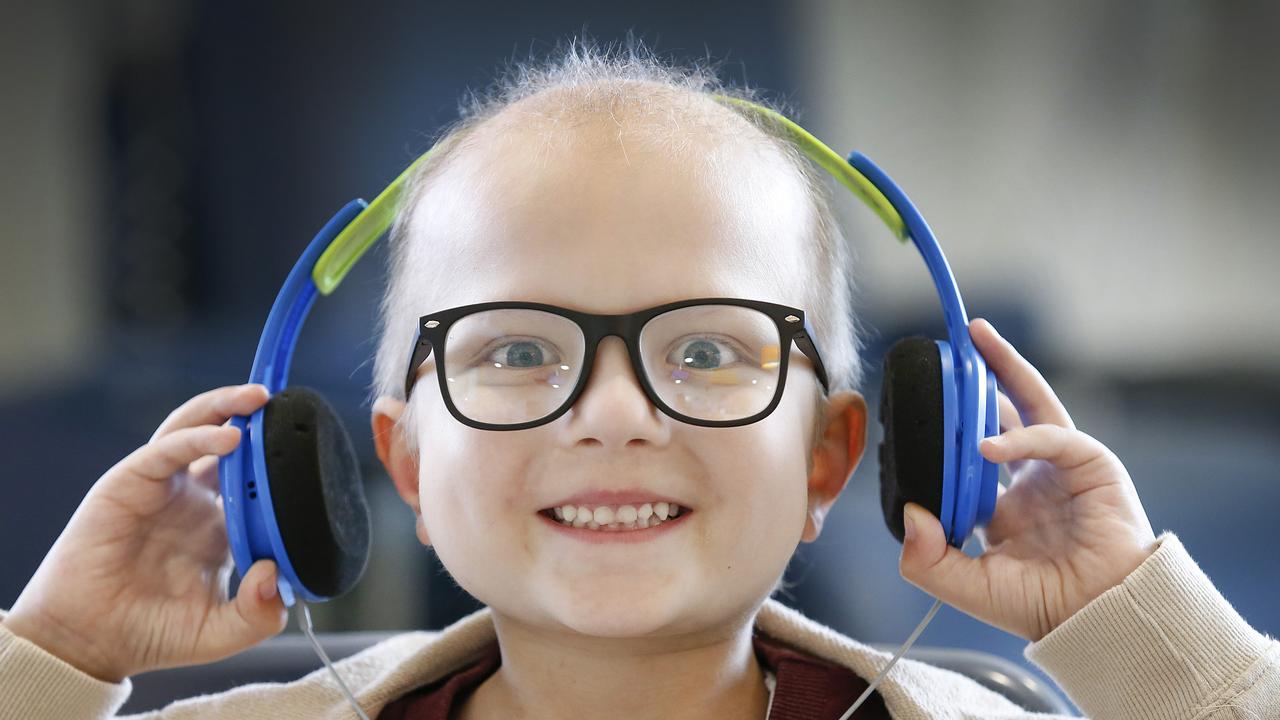
BASKETBALL STARS UNITE FOR KIDS
Victorians are being encouraged to dig deep into their pockets and show generosity to brave children for the upcoming Good Friday Appeal.
The countdown is now on for the year’s biggest fundraising campaign, with only five days left to beat last year’s record donation of $18.2m.
To support the appeal, Melbourne United basketballers Jock Landale and Jack White visited five-year-old heart surgery trouper Noah Sackett at the GFA Charity Home to help him score his first basket.
At three days old, Noah was diagnosed with Aortic Stenosis, a partial blockage of the aorta caused by a malformed valve exiting the heart, with immediate surgery required to save his life.
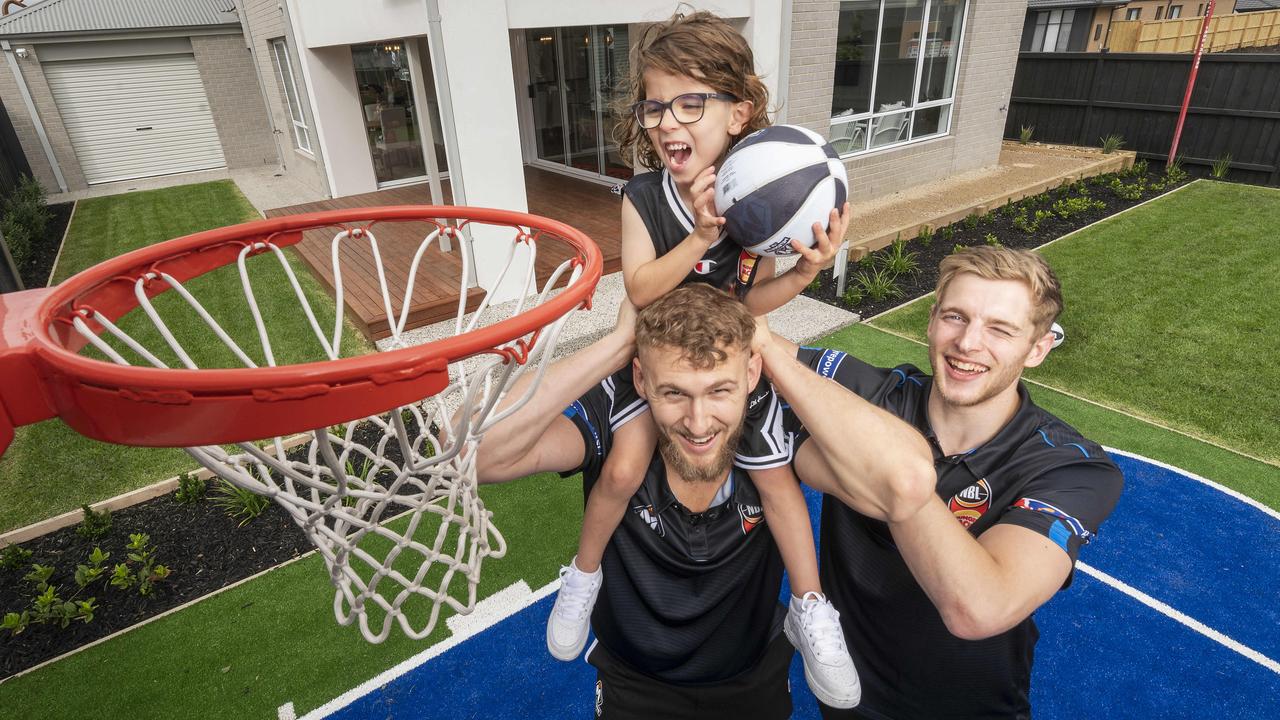
Parents Belinda and Chris Sackett had gone from celebrating the joy of their newborn’s arrival to seeing him being prepped for open heart surgery.
“The call came through after an agonising six hours, the surgery was a success and although we were told Noah would need another down the line, he was on his way to being out of the woods.
“Noah spent a few weeks in ICU and a week on the ward where the doctors and nurses did an amazing job caring for our little man.”
The charity home – the Vogue 34 by Henley Homes at Villawood’s Rathdowne Community in Wollert – will go under the hammer on April 2 in a no-reserve auction.
28-HOUR SURGERY TO REMOVE TUMOUR
Charlotte Alexander’s parents had heard the stories of miracles.
And so, with their young daughter’s life very much on the line, they put all their trust in the medical teams treating her.
A rapidly growing tumour had overtaken her entire abdomen, wrapping itself from the heart to the legs, and connected to blood vessels of every organ in between.
It took surgeons 28 hours of surgery, performed in two bouts over three days, to remove it, in the hardest tumour resection Royal Children’s Hospital surgeons have faced.
“She was supposed to be at kinder. It was her time to shine,” dad Craig Alexander said this week.
But her dad and mum Jess never questioned her chances of survival.
“At the end of the day … you’re never not going to go through with it,” Jess said.
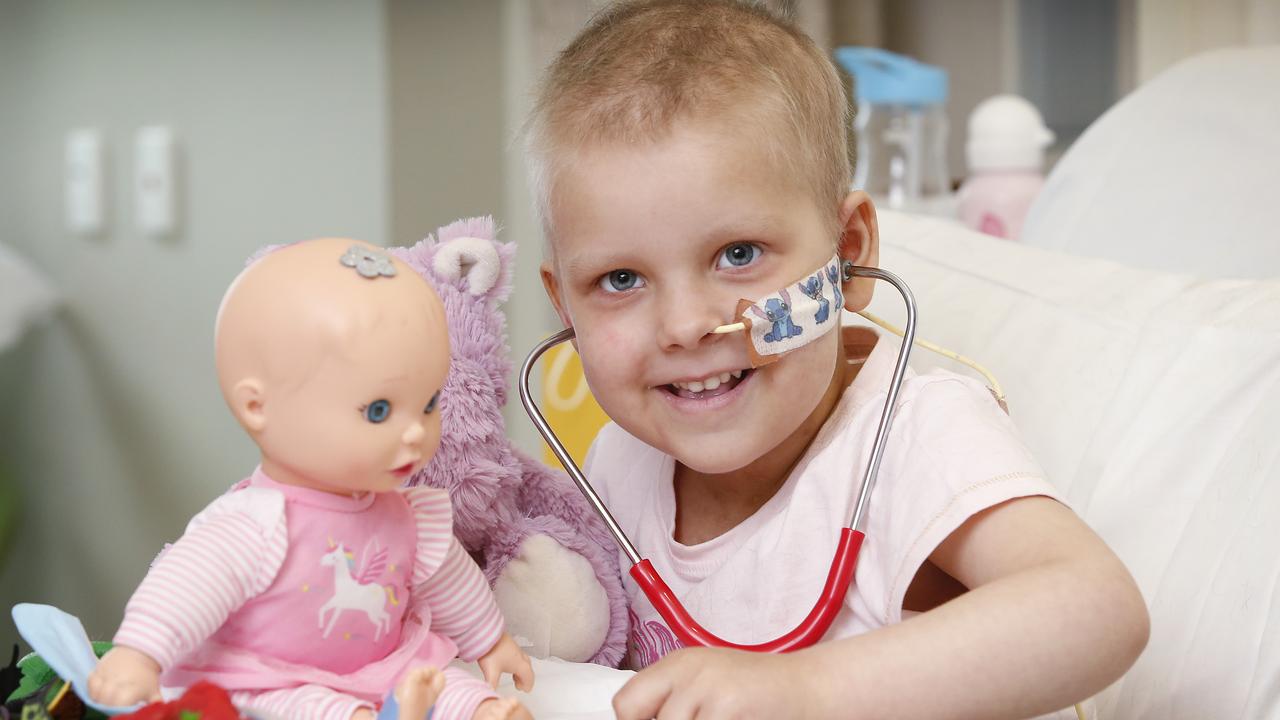
“The treatment is either going to work or it’s not. There are miracle stories out there. You still question, am I putting her through 18 months of very high intense treatment for no reason? But on the other hand, why wouldn’t you do it? … We put all our trust in them.”
Charlotte is a chatterbox and makes friends easily. Even if, for the time being, she’s having to swap the kinder sandpit for a tea party while hooked to an IV pole at the end of the oncology ward.
Not a weapon in the cancer treatment armoury is being spared. High-dose intensive chemotherapy, surgery, a stem-cell transplant, radiation and immunotherapy; her little body is hit by it all. And there are encouraging signs about her response to treatment.
Charlotte started complaining of stomach pains and going off her food in July.
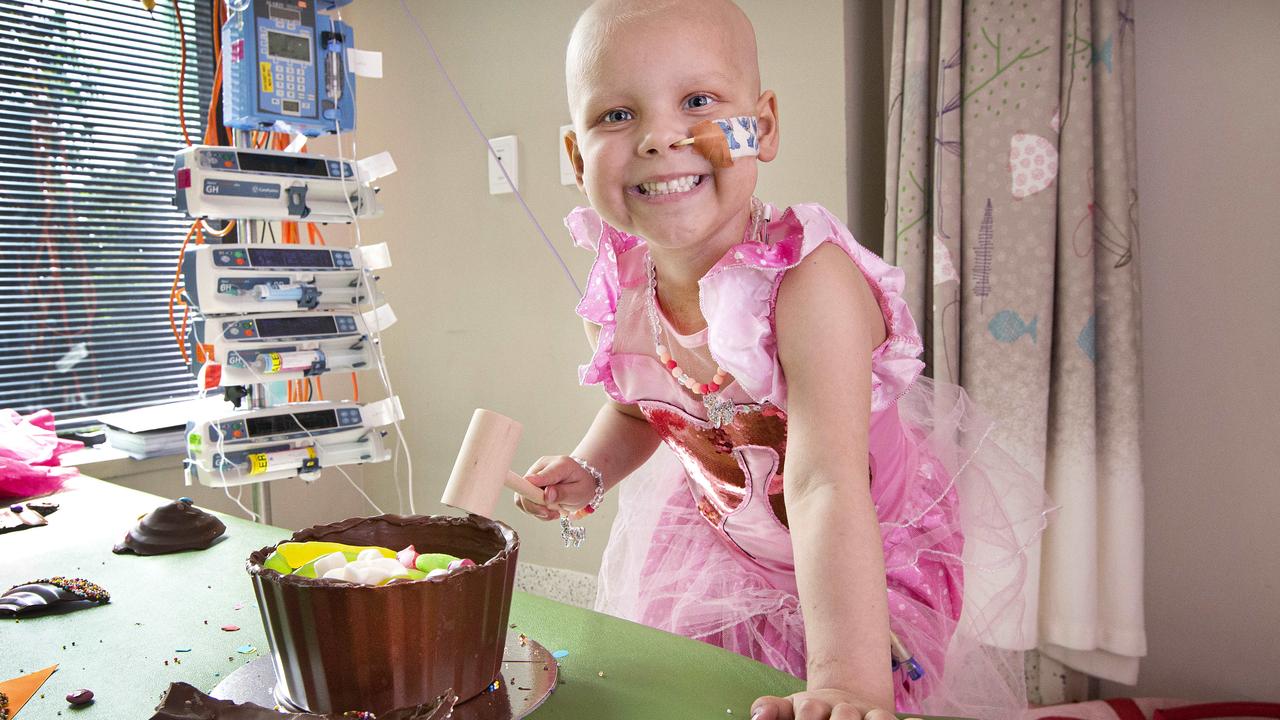
It took numerous GP telehealth appointments and three trips to the RCH emergency department before the cancer was found.
It was an ultrasound that revealed there was a mass pushing all the organs in her trunk out of the way. Within a week, the then three-year-old was receiving aggressive treatment.
“The most important thing in taking out these sorts of tumours is that we don’t do any harm … we have to go very slowly and carefully,” paediatric surgeon Michael Nightingale said.
They started operating at 8.30am. At midnight, and not even close to being done, they decided the safest option was to partially close her up, let her rest in intensive care, and then go in two days later for the final 13 hours.
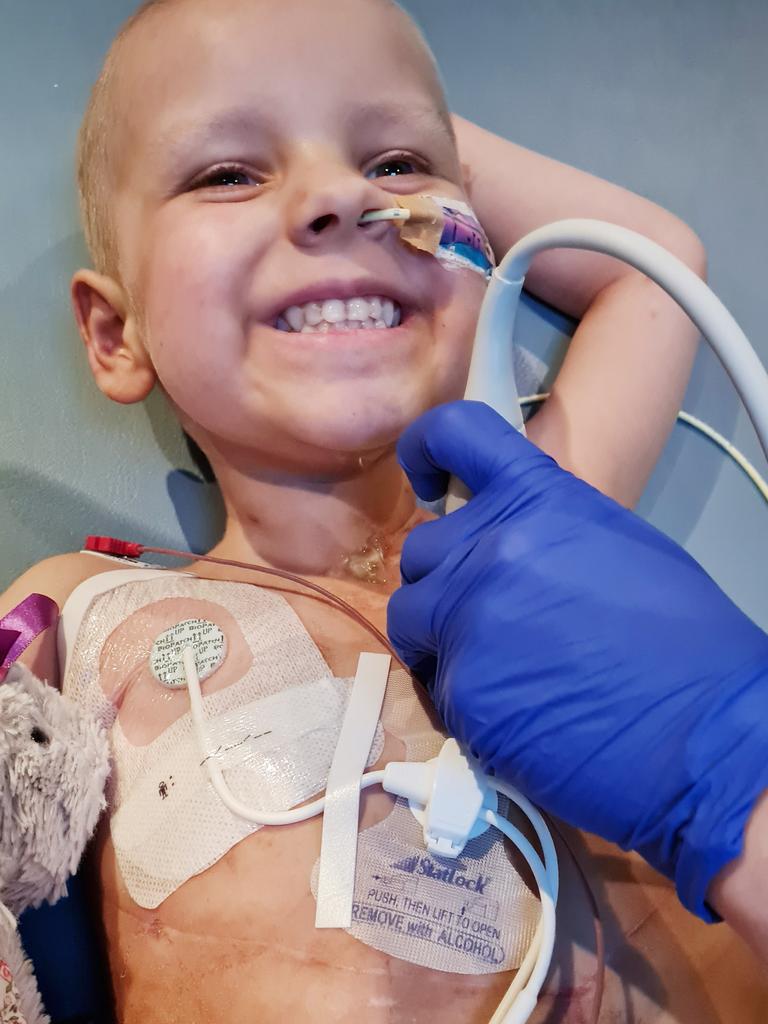
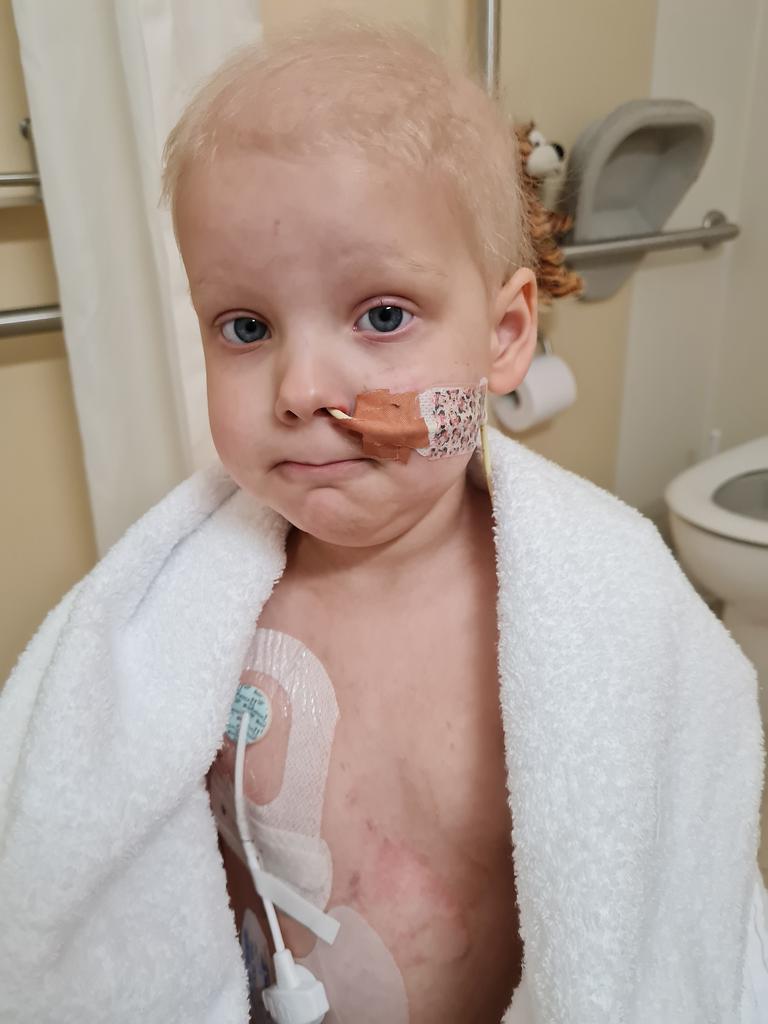
“She had the most extensive tumour that we’ve dealt with at the RCH, certainly in the 10 years I’ve been at the hospital,” he said.
A week after the surgery, there were hopeful signs.
Jess and Craig hung on to the good news as they watched their daughter learn to move again, after a month on a ventilator.
Radiation is next, followed by six months of immunotherapy.
At times, Charlotte’s parents have let themselves daydream about the future. Jess imagines her daughter being able to run under a sprinkler, without worrying about the port in her chest.
Ringing the gold bell at the exit of the oncology ward — a rite of passage for each child who finishes cancer treatment — is a recurring wish for Craig.
STANDING TALL SAVE ABUBAKAR’S SPINE
Ready to stand tall and report for the next stage of life, Abubakar Bakari is recovering from surgery aiming to allow him to walk on his own.
The boy has undergone new surgery to treat severe scoliosis. His spine was bent almost into the shape of a question mark in two directions — the sideways bend just as severe as his forward bend.
At seven, Abubakar is one of the youngest patients on which Royal Children’s Hospital orthopaedic surgeons have performed this procedure, which lengthened his spine using a sliding metal rod.
The Ardeer boy was born with a condition called arthrogryposis, in which joints and muscles fail to develop properly in the womb.
His dad Kassim said the condition had put his boy behind the starting blocks with development.
“He was still able to move and crawl around, but as the curve got pretty big, his balance was affected,” Mr Bakari said.

“He would be crawling on his knees, but he would fall down.
“Later when he was older, sometimes we would go around the block as a family, but he would need his walker.”
With Abubakar experiencing increasing discomfort from his back, it was clear this was the year he needed surgery to straighten his spine.
Scoliosis usually begins to affect people in the teenager years, so Abubakar has an unusual early-onset version.
“It was a bit scary,” Ms Bakari said. “It was a big operation.
“We didn’t go into too much detail with him. We just said ‘we need to do something for your back’.
“He doesn’t complain too much about pain, but he was starting to feel some pain.
“He knew it was affecting him.”
In theatre last week, director of the RCH’s orthopaedic department Michael Johnson and spinal surgeon Aaron Buckland implanted two connecting metal rods into Abubakar’s spine; one end was attached just below his neck, and the other to a vertebrae in his lower spine.

As he grows, the rods will slide apart to bring his spine into alignment.
The team has used this sliding “growth rod” French technique for the past three years, and has become the second-biggest site to do so.
Mr Johnson said: “This sliding mechanism is one I’d liken to a cable tie. It can slide in one direction to achieve length, but it can’t go backwards.
“The main benefit is to avoid more surgery, because growth can happen without us having to do any more operating.”
It is a surgery that might soon be in hot demand, given the unit has recently received multiple referrals of teenagers with scoliosis.
Mr Johnson said he speculated that with COVID lockdowns now ended, and teenagers now out, active and more visible to their parents, this could be behind the increased detection of back problems.
“It takes parents looking at their children and seeing the curve,” he said.
“One of the ways they get recognised is in dance class or phys-ed, and all of that wasn’t happening in lockdown.
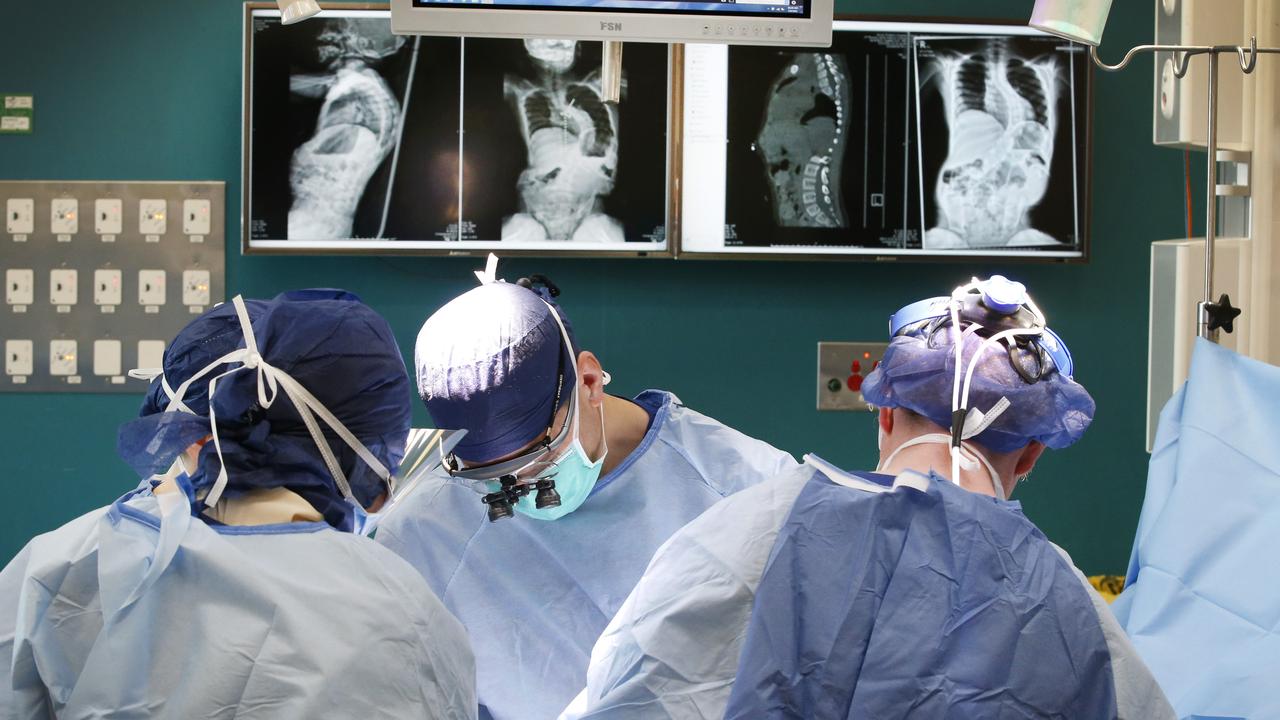
“Otherwise when kids are on holidays in their bathers, it’s spotted then as well. I suspect a lot of kids are not being observed in those settings and it hasn’t been noticed they’ve developed quite a big curve to their back — that’s the theory.”
Meanwhile, Abubakar has returned home.
His surgeons will monitor his condition over the next few years to see if any more treatment is needed.
“The ideal situation is he grows and extends these rods out to their full extent — about 5cm — and doesn’t need any more operating ever again. That would be the rolled gold result,” Mr Johnson said.
With Abubakar now keen to return to school next term, Mr Bakari said he hoped the surgery would free his boy to move through life with greater ease.
“He’s got a strong personality. I think what he’s been through has made him a much tougher kid,” he said.
“He’s a very switched-on boy so whatever he decides to do I hope he can do that.
“I think it will be something to do with vacuums, perhaps making or designing them.
“He is obsessed with them.
Donate now at goodfridayappeal.com.au
SIX DECADES OF HEALING HANDS
Six decades apart, Christine Phillpot and Finley Sherwood, have had reason to be thankful for the world-class care of Melbourne’s Royal Children’s Hospital.
Christine, 73, remembers the split-second dread of being caught in the middle of Canterbury Rd in the path of an oncoming car, like the accident was yesterday.
It was November 13, 1958, and the then 11-year-old had followed a friend across the main road, bound for Forest Hill Shopping Centre.
“I don’t remember being hit. I was thrown. I remember floating through the air. I thought I was dead. I thought I was floating up to heaven, until I heard my friend screaming,” Ms Phillpot said.

“I’d landed in the gravel. It wasn’t a sealed road in those days. I’m lucky I haven’t got scars on my face. When I came here to the hospital they wouldn’t give me a mirror. I could feel it all on my face. My leg was apparently bent back under me.”
The impact shattered her hip socket and broke her leg.
“My parents were told I probably would never walk again,” she said.
Ms Phillpot spent nine weeks in the intensive care unit of RCH, which was then on the corner of Pelham and Rathdowne streets in Carlton.
Surgeons drilled a hole through her calf bone and attached a horseshoe which was connected to traction. The rope that ran over the end of the bed was tied to a fruit can. Gradually each week more lead weights were added to slowly pull the bones apart and back into place.
Now a regular contributor to the Good Friday Appeal Ms Phillpott said she could walk today, because of amazing work of the hospital.

FINLEY SHERWOOD
It has taken a sleuth of medical marvels to unlock the secrets to Finley Sherwood’s tiny body. A new type of genetic testing has uncovered the rare disorder the Albury seven-month-old is carrying and allowed effective treatment to start.
“We’re seeing a very different baby now that she has got those very stable blood sugar levels,” mum Chantell Johnson said.
“She’s gone from a baby that screams all day, to a really cheeky, funny girl. She’s so social. The doctors come in and she’s blowing raspberries at them. She’s a real sweetie.”
Ms Johnson and partner Justin had noticed their baby had started to hang her chin on her chest, like she was constantly tired. Then she stopped being able to sit up, even when supported, as her trunk was sapped of its strength.
But it was after a day out on the river with her parents and siblings that her condition really worsened. Finley lay down on the floor at home, her legs and arms moving oddly and her eyes rolling back in her head.
She was mid-seizure.

In the battery of tests performed by paramedics on that day in late-February, Finley’s blood sugar levels were so low they barely registered on the machine. Hypoglycaemia had caused the seizures.
They pumped medicines, apple juice and glucose into her at Albury Hospital over the next two days, trying to boost the critically low blood sugar levels that threatened to starve her vital organs.
But with few tools left to treat her in the country, Finley was flown to the RCH.
“Teams came from everywhere; an endocrine team, metabolics, general medical, genetics. It was quite overwhelming. There were lots of doctors and lots of tests,” Ms Johnson said.
“The doctors have been blunt. They’ve said 10 years ago … the genetic test … wouldn’t have existed and we wouldn’t know what’s wrong with her.”
After a month in hospital, the pair are edging closer to home. Endocrinologist specialists from the RCH visit Albury every three months, so their next appointment will be in their home town.
“It’s a massive team behind us. There is an enormous amount of work that goes on behind the scenes. ”
Donate now at goodfridayappeal.com.au

BACK-TO-FRONT BOY SHOWS HEART
It has been a back-to-front beginning for Noah Doulkeridis, after his little body was found to be hiding an unconventional secret.
Noah was two days old when he was found to have a rare condition where his major organs – the heart, liver, stomach, lungs and spleen – are all reversed from their normal positions.
Rapid breathing and a fever caused a cluey nurse to order some extra tests.
“We were petrified. We thought; are we going to lose him? We didn’t know what it meant,” said mum Christine.
But given all the plumbing connecting Noah’s organs is just as is should be – just the organs themselves are a mirror image – this condition, remarkably, causes Noah no concerns.
What he does have daily treatment for now is a related illness.
The cilia, the tiny hairs that line the lungs, ears and nose, can’t move to clear out mucus and infections.

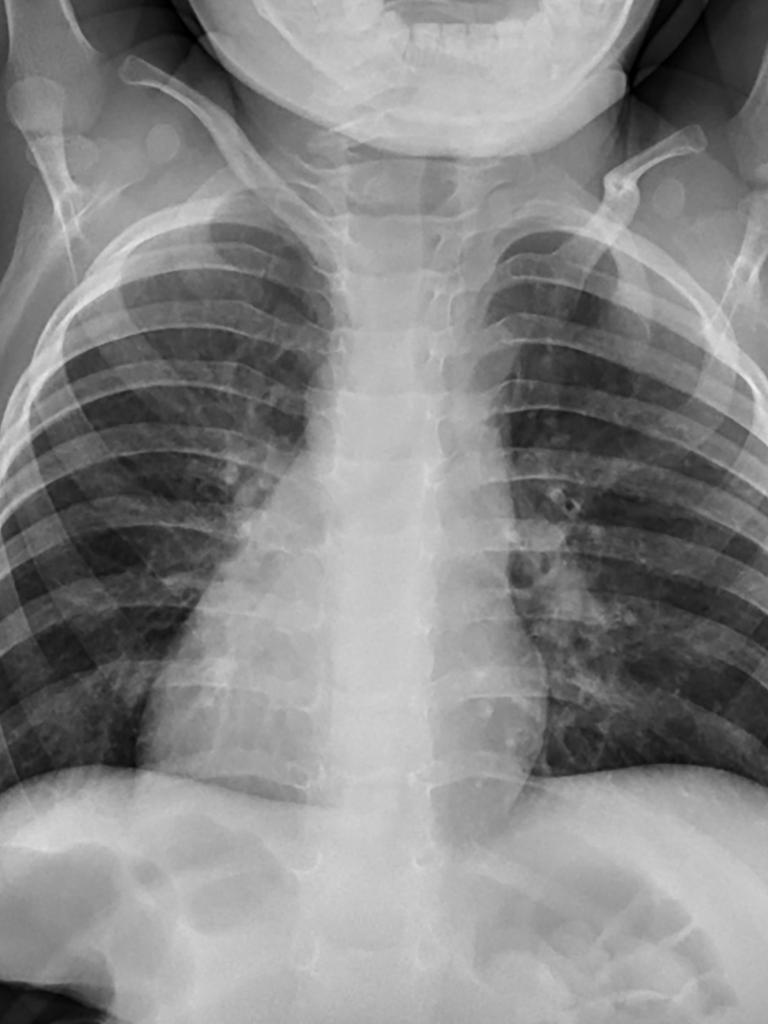
Imagine the worst head cold and the sensation of breathing into a pillow and this is what these children feel like all the time.
Noah, 3, is currently at the Royal Children’s Hospital for his yearly “tune up”.
“This is something he will experience for life, so I cry every day I’m there at the hospital out of happiness,” Ms Doulkeridis
“I’m so glad that we found them.”
LIFE CAN CHANGE IN AN INSTANT
In the blink of an eye the damage was done.
Ryan Haidari had not long found his feet. All arms and legs, the 14-month-old tore around the garage as his mum Sohaillah finished cooking.
She placed the pot of vegetable and bean stew they would take to the park for dinner on the shelf.
In the instant she turned her back to reach for the seasoning, the curious toddler pulled the hot pot down on top of himself.
It caused third degree burns across his face, chest and arms.
He was taken to the nearest hospital, but dad Ali said because of the burns on his son’s neck that were affecting his breathing, Ryan had to be transferred to intensive care at the Royal Children’s Hospital.
After skin grafts and almost a month in hospital, Ryan went in late March. He will return each week to the RCH burns clinic to have his dressings changed for the foreseeable future.
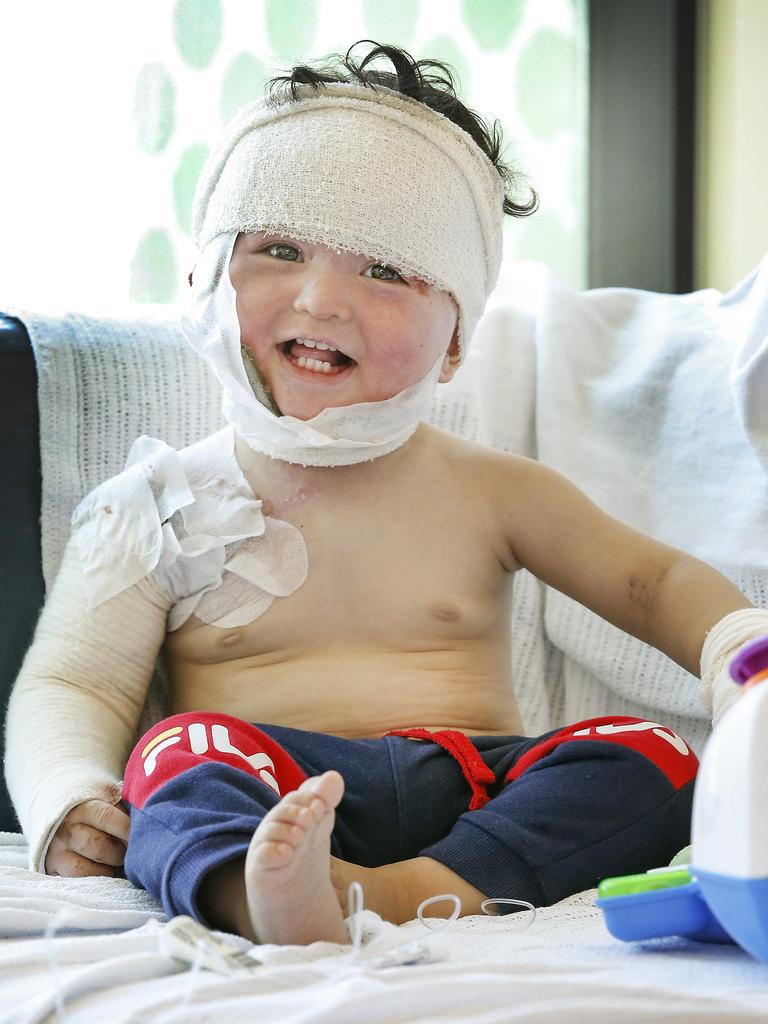
HARRY’S HAPPY REBOUND
The blood test results defied what doctors saw in front of them.
On paper, Harry Warnock should be critically ill with such a low blood count.
But as fast as the rare condition took hold of the then four-month-old’s kidneys, he recovered just as quickly thanks to a lifesaving drug and top-class medical system that joined its links across the state to help him.
Mum Lisa Warnock said it wasn’t until he started refusing feeds and sleeping all day her gut told her something wasn’t right.
Harry was sent straight from hospital in Benalla to Wangaratta.
With the results of his blood tests, the paediatrician there called Royal Children’s Hospital paediatric nephrologist Tom Forbes for advice.
PIPER, the Paediatric Infant Perinatal Emergency Retrieval team, was summoned to fly Harry to Melbourne.
Tests confirmed he had a rare abnormality of his immune and blood-clotting system, called haemolytic uraemic syndrome, which causes blood clots to form in vessels of the kidneys.

SAM’S SECOND FAMILY
From the first week of Samuel Edwards’ life, a healthcare army has been mobilised to carry out a trio of complex medical missions.
The 12-month-old had his first lifesaving surgery when he was barely a day old.
To parents Courtney Toms and Steve Edwards, their first born looked just as they imagined.
The only first sign that the lower end of Samuel’s digestive tract hadn’t developed properly was when he had still not had his first bowel movement on his second day of life.
Samuel was rushed to the Royal Children’s Hospital for a stoma to be implanted, buying them time for a more permanent fix.
“Unless you were looking, you wouldn’t know, so it came as a big shock,” Ms Toms said.
By the time the couple could take their baby home after spending three weeks in intensive care, it had been found Samuel also had heart and kidney defects.
He will receive treatment for those conditions later, but at the moment he is a patient at RCH’s newly formed colorectal and pelvic reconstruction service
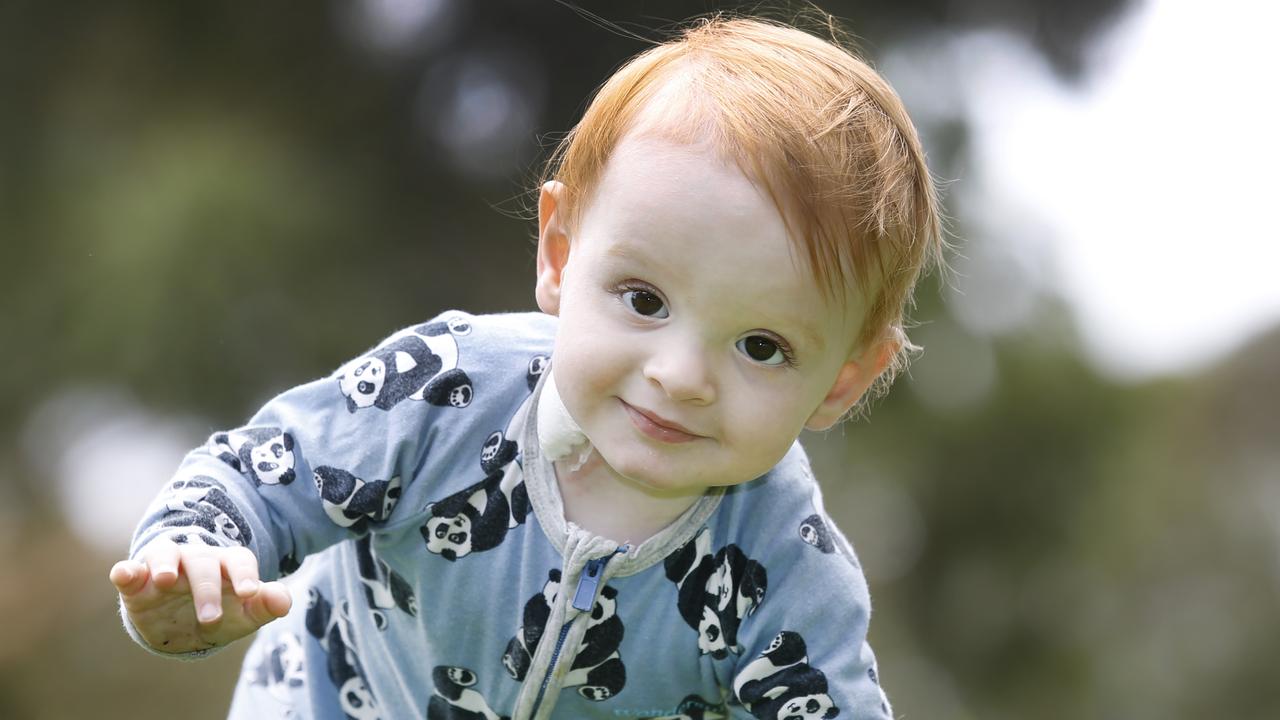
SUCH GRACE AND STRENGTH
With her princess dress and runners on, her beloved doll buckled into its pram, Grace Antonello hits the track for her morning walk.
The two-year-old is tethered to an IV pole, but that doesn’t slow her down as she cuts laps of the Royal Children’s Hospital oncology ward.
It’s been a daily ritual — when she’s been well enough — to stop and check in on friends across the hall, and finish with a pit stop at the nurses’ station to do some drawing on their paperwork.
Grace’s leukaemia diagnosis five months ago shattered her parents Jessica Mekken and Daniel Antonello.
But Ms Mekken said her daughter was inspiring in how she had adapted to her new way of life, stuck largely in a hospital ward.

HENRY’S WORKING ON WALKING
To be able to put one foot in front of the other, Henry Bryant is learning to walk all over again.
But the 4-year-old has proved at every hurdle he is up for the challenge.
Henry is putting all his determination into intensive rehabilitation after complex spinal surgery to treat muscle tightness from cerebral palsy, that is aiming to see him painfree and moving more freely.
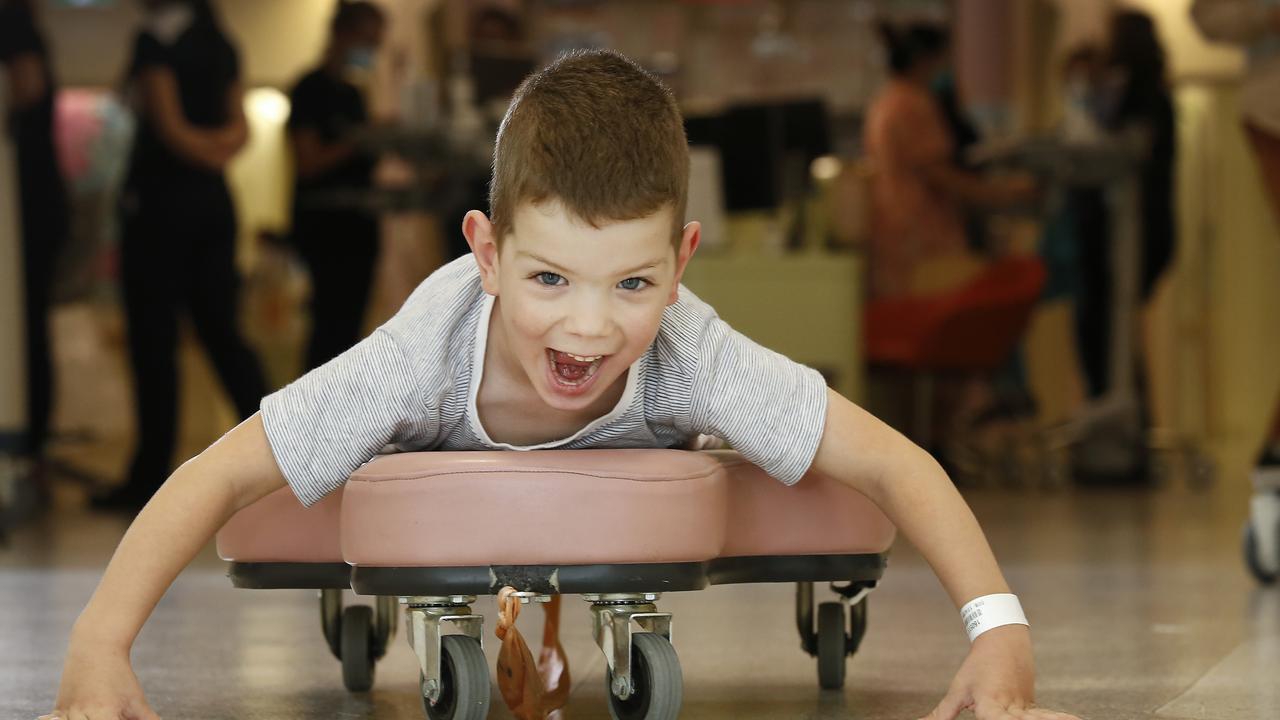
LITTLE LUNA REACHES OUT
Luna Phillips watched the older girl opposite her in day oncology with concern.
She is only three, but Luna knew this girl was anxious, so she held out her hand and hung on tight so her new friend wouldn’t be scared.
Next, she saw a boy crying on the same ward. She asked her mum if she could make him a card so he would feel better.
“As a parent you think, ‘Luna, you’re going through so much yourself’, but she’s always looking for a way to make other people feel better,” said mum Laura.
“We always knew she was a special little soul, but we’re seeing it a lot now. We’re getting our strength from her.”
The Wangaratta girl, 4, is new to cancer treatment — three months into what will be a three-year process.

BRAVE HANNAH HAPPY TO HELP
Hannah Bradley hands the nurse an alcohol wipe and holds her plastic IV line still, ready for it to be changed.
“I help you,” she tells them, pointing to the syringe and clutching her doll with the other hand.
She is only two, but after eight months of cancer treatment she feels she has earned her stripes.
More Coverage
“We call her nurse-in-training here,” said dad Mark Bradley. “She’s very observant. She watches something a couple of times, then she’ll get the prep pads to help the nurses clean her lines.
“She quite enjoys it here. She enjoys the attention, I think.”

MALU’S RADICAL SURGERY
Originally published as Good Friday Appeal 2021 RCH: Faces of the Royal Children’s Hospital


